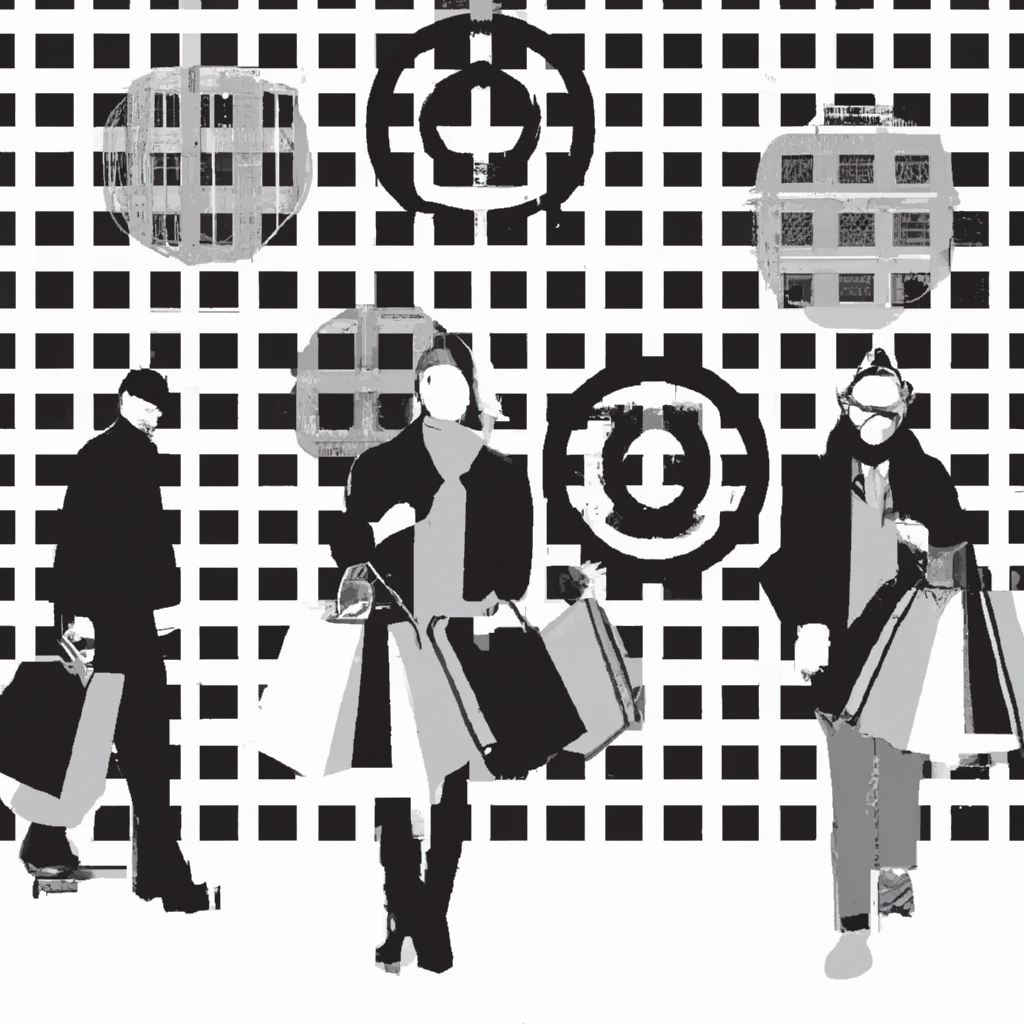High-level findings
Total visits to stores on Black Friday in 2023 decreased by approximately 21.51% compared to 2019. This likely represents a decrease of $1.6 billion of in-store purchases.
Compared to last year (2022), 2023 Black Friday visits were down by 3.77% Based on Mastercard data and other data sources, this represents a decrease of approximately $92.74 million.
The category that saw the biggest improvement during the week of Black Friday in 2022 was Electronics (+7.73%), compared to the same period in 2022. Department stores also saw a slight increase across the same parameters.
Some brands that showed big increases on the day of Black Friday in 2023, compared to 2022 were Akira (+61.43%), Shoe Station (+52.09%) and Bealls Outlet (+45.60%).
On just the Friday, Office supply stores showed the biggest growth (+10.46%)
Geographically, shoppers in Alaska and Mississippi showed the biggest increase in visits compared to last year.
About this report
This report uses foot traffic data for the last 5 years across the US during the Black Friday shopping period.
The data is broken down into brand, category and state levels for analysis.
Data is generated using pass_by’s proprietary AI-powered model, which can understand foot traffic to POIs with unprecedented accuracy. More about this methodology can be explored in the methodology section.
Category-Specific Analysis
This is a comparison of the Black Friday shopping week:
| Top Category | 2019-2020 Increase (%) | 2020-2021 Increase (%) | 2021-2022 Increase (%) | 2022-2023 Increase (%) |
|---|---|---|---|---|
| Beer, Wine, and Liquor Stores | -36.86 | 39.67 | 3.30 | -2.50 |
| Book Stores and News Dealers | -26.38 | 18.78 | -10.40 | 2.63 |
| Clothing Stores | -51.79 | 67.96 | -3.00 | -8.22 |
| Department Stores | -58.74 | 46.20 | -2.90 | 1.20 |
| Electronics and Appliance Stores | -54.85 | 76.07 | -1.97 | 7.73 |
| Florists | -18.13 | 4.22 | -11.89 | 1.12 |
| Furniture Stores | -42.63 | 18.53 | -2.71 | -17.14 |
| General Merchandise Stores | -35.46% | 23.21% | -8.19% | -5.69% |
| Grocery Stores | -19.84 | 19.69 | -4.87 | -4.20 |
| Health and Personal Care Stores | -22.55 | 16.44 | -7.20 | -3.91 |
| Home Furnishings Stores | -32.04 | 23.20 | -12.19 | -28.65 |
| Jewelry, Luggage, and Leather Goods Stores | -54.14 | 60.42 | -3.25 | -10.53 |
| Lawn and Garden Equipment | -33.77 | 29.79 | -75.47 | -1.66 |
| Office Supplies, Stationery, and Gift Stores | -30.35 | 9.03 | -12.81 | -3.02 |
| Shoe Stores | -48.60 | 54.46 | -4.00 | -3.86 |
| Specialty Food Stores | -64.80 | 104.28 | -30.06 | 22.63 |
| Sporting Goods, Hobby, and Musical Instrument Stores | -42.92 | 46.22 | 1.48 | -6.39 |
If we look at the data for just Black Friday then the trends are a little different:
| Brand Category | 2019-2020 Increase (%) | 2020-2021 Increase (%) | 2021-2022 Increase (%) | 2022-2023 Increase (%) |
|---|---|---|---|---|
| Beer, Wine, and Liquor Stores | -50.78 | 64.09 | 5.27 | 0.82 |
| Book Stores and News Dealers | -37.83 | 21.89 | -6.61 | 8.30 |
| Clothing Stores | -61.97 | 101.52 | 0.07 | -6.26 |
| Department Stores | -52.19 | 59.91 | -5.41 | -2.47 |
| Electronics and Appliance Stores | -68.20 | 125.88 | 16.83 | -1.41 |
| Florists | -31.08 | 7.97 | -8.94 | 5.78 |
| Furniture Stores | -43.64 | 25.25 | 0.61 | -17.26 |
| General Merchandise Stores | -33.50% | 26.17% | -1.04% | -10.02% |
| Grocery Stores | -22.47 | 22.50 | -3.57 | -2.52 |
| Health and Personal Care Stores | -27.50 | 20.31 | -3.95 | -1.32 |
| Home Furnishings Stores | -44.15 | 40.38 | -15.99 | -22.37 |
| Jewelry, Luggage, and Leather Goods Stores | -66.25 | 92.66 | -0.65 | -4.55 |
| Lawn and Garden Equipment and Supplies Stores | -49.74 | 47.32 | 6.13 | -0.61 |
| Office Supplies, Stationery, and Gift Stores | -40.46 | 12.79 | -15.04 | 10.46 |
| Shoe Stores | -59.98 | 79.85 | 2.48 | -2.99 |
| Specialty Food Stores | -69.47 | 60.12 | 20.33 | -0.15 |
| Sporting Goods, Hobby, and Musical Instrument Stores | -55.11 | 75.81 | 15.62 | -12.56 |
Black Friday 2023
Electronics and Appliance Stores experienced a significant increase of 7.73% in visits during the holiday shopping period in 2023 over the previous year
In 2023, Electronics and Appliance Stores witnessed a significant increase in visits, recording a 7.73% growth during the holiday shopping period over the previous year. This surge aligns closely with the global market trends for electronics and appliance stores, which saw an expansion from $1,027.99 billion in 2022 to $1,105.73 billion in 2023, at a compound annual growth rate (CAGR) of 7.6%. The rise in market size is partly attributable to the disruptions caused by the Russia-Ukraine war, which impacted global economic recovery post-COVID-19. These disruptions led to economic sanctions, surges in commodity prices, and supply chain disruptions, resulting in inflation across various goods and services.
A key factor driving the growth in Electronics and Appliance Stores is the adoption of data analytics in management. This technological integration is utilized to enhance supply chain efficiency, streamline operations, engage customers, and build loyalty. With the global retail analytics market reaching $5.1 billion in 2020, the proliferation of retail data and technologies for data analysis has made it increasingly feasible for these stores to identify and meet customer needs and expectations, propelling the market forward.
For example companies such as Best Buy, Conn’s and Fry’s Electronics have been doing just that. These global electronics and appliance stores have implemented technologies like traffic-tracking sensors, RFID tags, handheld scanners, and heat maps. These tools provide a real-time snapshot of consumer behavior, assisting in real-time stock management, inventory controls, and demand forecasting.
In the United States, the electronics and appliance stores market has been influenced by several factors, including increased consumer spending on electronics and appliances and the growing trend of smart homes. Consumers are increasingly inclined towards smart home products, such as smart speakers, home security systems, and smart thermostats, which has contributed to the growth in this sector.
The 7.73% increase in visits during the 2023 holiday period is indicative of these broader market trends. It reflects a consumer shift back to physical retail experiences in electronics and appliances, possibly driven by the desire to experience products firsthand, benefit from in-store expert advice, and the immediate gratification of in-person shopping. This trend is noteworthy for industry observers and journalists, as it suggests a robust recovery and potential shifts in consumer behavior in the post-pandemic era.
Department Stores saw a modest increase during the week of 1.20% in visits, suggesting a slight rebound from last year
This year’s Black Friday week witnessed a promising trend in the foot traffic for Department Stores, marking a modest yet significant rebound from the previous year’s figures. The data reveals a 1.20% increase in visits compared to the same period last year. This uptick, though seemingly small, is indicative of a positive shift in consumer behavior and confidence.
The increase in foot traffic can be attributed to several factors. Firstly, Department Stores have been adapting to the changing retail landscape, offering a more integrated shopping experience that combines the convenience of online browsing with the tactile benefits of in-store shopping. This approach appears to be resonating with customers who value both the efficiency of online research and the experiential aspect of in-store purchases.
Furthermore, the strategic promotional activities undertaken by many Department Stores in the run-up to Black Friday may have played a crucial role. These promotions, often tailored to align with consumer preferences and shopping habits, have likely contributed to attracting more visitors.
Another aspect to consider is the consumer sentiment towards physical retail spaces. As the world gradually moves past the peak phases of the pandemic, there is a noticeable shift in consumer attitudes, with a renewed interest in in-person shopping experiences. This change is reflected in the increased foot traffic, suggesting that Department Stores are successfully capitalizing on this renewed interest.
While the growth is modest, it is a positive sign for the sector, indicating a recovery trajectory. It also serves as an impetus for Department Stores to continue innovating and adapting to the evolving retail landscape, focusing on customer experience and engagement to sustain and enhance this growth trend.
In conclusion, the 1.20% increase in visits during the Black Friday week is a hopeful sign for Department Stores. It points towards a rebound from the challenges of the previous year and sets a foundation for potential growth in the coming periods. As the retail sector continues to evolve, Department Stores that leverage customer-centric strategies and embrace the blend of digital and physical retail are likely to see continued success.
The larger increase YoY for the period vs just the day of Black Friday suggests that consumers are more likely to go shopping outside of the Friday, compared to pre-pandemic.
This heightened performance over the week-long period seems to indicate a shift in consumers’ shopping habits. Rather than concentrating shopping efforts solely on Black Friday itself, consumers may be taking advantage of deals distributed throughout the week. This suggests that retailers are possibly extending their promotional efforts. They, in turn, are providing an expanded time frame for consumers to enjoy the benefits of the Black Friday sales. This more spread out approach to offering deals might be a new tool for retailers to manage and distribute their foot traffic more evenly.
Market share by category
Top 5 categories by market share
In the landscape of physical retail, the distribution of market share by category during Black Friday 2023 highlights the prevailing consumer preferences and the resilience of certain sectors. Leading the market share is the category of General Merchandise Stores commanding a substantial 47.51%. This dominance reflects the consumer’s preference for one-stop shops where a wide array of products, from groceries to electronics, can be purchased in a single visit.
Grocery Stores, with a market share of 14.87%, underscore the essential nature of this sector. Despite the growth of online grocery shopping, physical stores continue to attract customers, possibly due to the sensory experience of selecting fresh produce and the immediacy of purchase.
Clothing Stores follow, holding 10.87% of the market share. This suggests that despite the rise of online shopping, the tactile experience of trying on clothes and the immediate gratification of an in-store purchase remain important to consumers.
Department Stores, often seen as vulnerable in the digital age, show a modest but significant market share of 9.80%. This could indicate a successful adaptation to changing consumer behaviors or a renewed interest in the traditional department store experience.
Lastly, Health and Personal Care Stores, with a 4.83% market share, highlight the importance of these outlets. The tactile nature of purchasing personal care items, the ability to receive immediate advice, and the experience of shopping for health-related products in a physical environment contribute to their sustained relevance.
These figures provide a snapshot of the current state of physical retail, offering insights into consumer behavior and the evolving landscape of in-store shopping. They indicate a blend of traditional shopping habits with emerging trends, painting a picture of a dynamic retail sector adapting to the changing needs and preferences of consumers.
Last 5 years
Department Stores: Navigating Market Changes
Department Stores had a significant 40.72% decrease in visits from 2019 to 2023.
The 40.72% decrease in foot traffic for Department Stores over five years signifies a profound shift in the retail landscape. This downturn could be attributed to several factors, including the rise of e-commerce, changing consumer preferences, and the impact of global events such as the COVID-19 pandemic. Department Stores have been facing growing competition from online retailers and a need to innovate in customer experience and product offerings.
The Changing Face of Clothing Stores
Clothing Stores witnessed a 27.91% decrease in visits over these five years.
Clothing Stores, much like Department Stores, have seen a 27.91% decrease in foot traffic over these years. This decline could be reflecting a shift towards online shopping, with consumers increasingly turning to e-commerce platforms for their clothing purchases. Additionally, this trend could be influenced by the rise of fast fashion, changes in consumer preferences towards more sustainable options, and the impact of social media on fashion consumption. The decline also raises questions about the future of physical retail spaces for clothing, and how these stores can adapt to changing consumer demands.
2021: A Beacon of Hope
The year with the highest overall increase in visits was 2021, indicating a recovery phase from the previous year’s decline.
The year 2021 stands out as a period of recovery, with the highest overall increase in visits suggesting that consumers were eager to return to in-person shopping experiences post the initial wave of the pandemic. This recovery phase could be attributed to pent-up consumer demand, the easing of pandemic-related restrictions, and a general sense of returning to normalcy. It’s also reflective of the resilience of the retail sector and its ability to adapt to unprecedented challenges.
2020: The Impact of the Pandemic
2020 saw the most drastic annual declines across almost all store categories, with Department Stores being the hardest hit at -58.74% compared to 2019.
The year 2020 was marked by significant challenges for the retail sector, with widespread declines across almost all store categories. The -58.74% plunge in visits to Department Stores highlights the acute impact of the pandemic, particularly during the lockdowns and periods of high uncertainty. This decline reflects not only the immediate effects of the pandemic but also underscores the vulnerabilities of physical retail in the face of such global disruptions.
A Positive Trend for Electronics and Appliance Stores in 2022
In 2022, Electronics and Appliance Stores had the highest annual increase in visits at 18.78% compared to 2021.
The 18.78% increase in visits to Electronics and Appliance Stores in 2022 compared to 2021 points to a growing consumer interest in technology and home appliances. This could be driven by the increased time spent at home during the pandemic, leading to greater investment in home improvement and technology. The growth in this sector also suggests a successful adaptation to the challenges of the previous years, possibly through enhanced in-store experiences or effective integration of online and offline sales channels.
Brand-Specific Observations
As we delve deeper into our comprehensive report, we shift focus towards specific retailers that have made interesting strides over the past five years. These select brands offer valuable insights and learning opportunities for other retailers aiming to enhance their Black Friday performance. Keep reading for an in-depth examination of how brands fared during Black Friday.
2023
This year’s winners when we look at all brands:
The recent Black Friday data reveals a fascinating resurgence for some physical retailers. This trend is particularly evident in the impressive foot traffic increases seen across a diverse range of stores, showcasing the enduring appeal and unique experiences offered by in-store shopping during one of the biggest retail events of the year.
Akira leads with a 61.43% increase in store visits, a clear indication of the brand’s strong appeal during the holiday shopping season. This is closely followed by Psycho Bunny, which saw a 55.55% rise, suggesting that its distinctive and appealing fashion choices resonate strongly with holiday shoppers.
Shoe Station’s 52.09% increase points to the fact that customers value the experience of trying on and purchasing footwear in person, especially when deals are at their best during Black Friday. Similarly, Bealls Outlet recorded a 45.60% increase, reflecting consumer enthusiasm for exploring a wide range of products and enjoying the thrill of finding Black Friday bargains.
Miss A’s rise in visits by 42.24% underscores the allure of its affordable yet trendy offerings, appealing to a wide demographic looking for value during the shopping holiday. The 36.91% increase for MCM Worldwide indicates a robust interest in luxury shopping, with consumers taking advantage of Black Friday deals to indulge in high-end products.
The 32.22% increase at Fat Tuesday suggests a revival in leisure and experiential shopping, while Neighborhood Goods’ 30.64% rise highlights the growing attraction of stores offering a unique blend of products and community feel. The increase in foot traffic at Books-A-Million by 29.62% celebrates the charm of physical bookstores, and Bomgaars’ 29.52% increase shows sustained interest in home improvement and agricultural supplies.
These trends during Black Friday indicate a robust and vibrant state for physical retail, where consumers enthusiastically engage in the tangible, communal, and experiential aspects of in-store shopping. This resurgence is a positive sign for retailers, reaffirming the value and excitement of the in-person shopping experience during one of the busiest shopping periods of the year.
Last 5 years – interesting brand case studies for retailers
As we explore the five-year historical data, intriguing patterns emerge from the brands that best represent the evolving retail landscape. These brands tell an interesting story during the Black Friday period. These stories offer valuable lessons and could serve a source of inspiration. Understanding their journey can empower retailers to effectively harness the potential of the Black Friday shopping window. Let’s delve deeper into these captivating brand stories.
Kohl’s
Black Friday Trend: A massive drop in 2020 with a partial recovery in 2021, but not reaching pre-pandemic levels even by 2023.
Kohl’s, a notable player in the retail landscape, faced significant challenges and transformations during and post the COVID-19 pandemic according to our data. In 2020, the brand experienced a sharp decline of 52.38% in store visits on Black Friday. This was followed by a substantial recovery in 2021, with an increase of 56.00%, although this rebound did not bring the store visits back to pre-pandemic levels. 2022 saw a further drop of 8.35%, and in 2023, store visits decreased by an additional 3.28%.
The narrative of Kohl’s during this period reflects broader challenges faced by traditional department stores in the pandemic era. The pandemic provided an opportunity for Kohl’s to refocus and reposition its strategy. Michelle Gass, the CEO of Kohl’s, emphasized the importance of decisive leadership and a shift from survival to growth. The company’s strategy involved tightening its focus and moving away from the traditional department store model. Kohl’s aimed to establish itself as a specialty lifestyle concept, with an emphasis on categories like casual apparel, athleisure, outdoor products, and wellness and beauty.
Another significant shift for Kohl’s was its adoption of digital strategies. Recognizing the convenience of e-commerce, Kohl’s worked on becoming a winning omnichannel retailer. The brand quickly implemented curbside pickup, which helped maintain customer engagement with physical stores while enhancing their digital experience. This strategy proved beneficial as customers who shopped through both channels were found to be significantly more productive.
Kohl’s also made strategic partnerships, notably with Sephora, to transform the in-store experience. Additionally, the brand focused on offering simpler value to customers, streamlining its pricing strategies and coupon systems, in response to consumer demands for straightforward pricing.
Bealls Outlet:
Data Trend: Remarkable growth starting in 2020 and continuing to rise through 2023.
Bealls Outlet, a prominent name in the retail industry, demonstrated a unique growth trajectory during the COVID-19 pandemic, marked by significant changes in strategy and business approach. Under the leadership of CEO Matt Beall, the company navigated the disruptions caused by the pandemic, embracing both internal and external changes. This proactive approach was guided by the philosophy passed down by Beall’s grandfather: to avoid stagnation and continually evolve.
A key strategic move was the rebranding of Bealls Outlet and Burkes Outlet to simply ‘bealls’, and the non-outlet stores in Florida to ‘Bealls Florida’. This change, announced in April, coincided with a 9% increase in foot traffic and a 5% rise in sales by June at the revamped locations. This shift reflects the company’s adaptability and willingness to invest significantly in its brand identity, catering to evolving market demands.
In addition to these changes, Beall expressed enthusiasm for leveraging technology to enhance customer-centricity. The focus extended beyond the main brand to include subsidiaries like Home Centric and Earth Rugged Outfitters, positioning them for future growth. This forward-thinking approach underscores Bealls’ commitment to innovation and customer engagement, crucial in an increasingly digital retail landscape.
These strategic decisions and adaptations highlight Bealls Outlet’s ability to thrive during a period of widespread retail challenges. The company’s success story, “Thriving in a Pandemic: Bealls Outlet’s Unprecedented Growth Story”, is not just about weathering a crisis but about seizing opportunities to redefine and strengthen its market position in a rapidly evolving retail world.
Bed Bath & Beyond:
Data Trend: A steep decline in 2020, a slight recovery in 2021, but a continued decline in 2022 and 2023.
Bed Bath & Beyond, once a dominant player in the home goods retail sector, experienced a notable decline during the COVID-19 pandemic, as reflected in our data. The brand saw a substantial decrease of 48.55% in store visits during Black Friday 2020, followed by a partial recovery of 21.14% in 2021. However, this rebound was not sustained, leading to further declines of 27.32% in 2022.
The challenges Bed Bath & Beyond faced were exacerbated by the pandemic’s impact on physical retail, leading to the closure of most of its stores. These difficulties culminated in the company preparing to file for bankruptcy as early as April 2023, as reported by the Wall Street Journal. The retailer’s shares tumbled nearly 23%, indicating a significant decrease in investor confidence. This decline in demand and the company’s strategy to focus more on store-branded products, which did not resonate well with customers, contributed to its financial struggles.
In response to these challenges, Bed Bath & Beyond explored various financing options to support itself during the bankruptcy process. Additionally, the company had announced plans to sell $300 million worth of shares in March, warning that failure to do so might necessitate a bankruptcy filing.
Geographical Insights
Taking the geographical point of view, the impact of Black Friday on foot traffic tunes differently from state to state, city to city. The fluctuations in consumer behavior largely depend on the local economic conditions and retail trends. Let’s dive deeper and explore some of the major trends observed during Black Friday.
State level analysis
Increase on 2022
Increase from 2022 by state
Impact of the Pandemic on Physical Retail
The onset of the global pandemic unquestionably reshaped the retail landscape, as demonstrated by historical foot traffic data over the past five years. Retailers across various sectors were compelled to adapt to new consumer behaviors and shifting market trends.
The year 2020 in particular was a significant turning point, as nationwide lockdowns resulted in unprecedented changes in retail foot traffic. The need for social distancing and fear of virus transmission led to a sharp decline in physical shopping and drove an extraordinary surge in online shopping. This was a trying period especially for department stores and clothing retailers who traditionally rely heavily on in-store shopping.
Despite these setbacks, 2021 emerged as a beacon of hope. With the economy slowly opening up, consumer confidence gradually returned, and so did foot traffic to retail stores. Department Stores, at this point, showed resilience by implementing strategic changes to navigate through this new retail environment. This era saw a rise in omni-channel marketing, blending the physical and digital shopping experience, and highlighting the importance of a fluid, adaptable strategy in the retail market.
Interestingly, Electronics and Appliance Stores seemed to fare much better during this period. 2022, in fact, showed a positive trend with a significant increase in foot traffic for this category. What we can discern from this data is that essential and high-valued products were priorities for consumers during this period of uncertainty and lifestyle adjustments.
Several interesting brands surfaced during the last five years that retailers could learn from. Kohl’s, for instance, actually saw an uptick in shopper visits, showing how endurance and adaptability can pay off.
By studying these trends and behaviors on a granular level, retailers can glean valuable insights that can help them adapt and thrive in even the most challenging market conditions. This analysis is not just a snapshot of Black Friday shopping patterns in the recent past, but a comprehensive guide to understanding how rapidly and profoundly the retail sector can change, and how businesses can equip themselves to not just weather storms, but leverage them for success.
Implications for Retailers
From a retail perspective, the importance of understanding foot traffic data, as utilized in this in-depth report, cannot be overstated. Changes in foot traffic are an immediate and efficacious indicator of customer trends, behaviors, and preferences, providing valuable insights that can inform key business decisions. Utilizing this data effectively can allow retailers to optimize their strategies during peak shopping seasons, such as Black Friday.
Seeing as Electronics and Appliance Stores witnessed a notable increase of 7.73% in visits in 2023 over the previous year, there’s a clear trend that could potentially translate into an opportunity for retailers in that space. Retailers of such goods can isolate what factors might have contributed to this surge and try to replicate these in future campaigns, product mixes, or service offerings.
Department Stores, despite the modest 1.20% increase, should not undermine their progress. Even a slight upturn in foot traffic predicts increased consumer confidence and spending within your space. This is a positive signal that can justify investments in customer-focused initiatives such as loyalty programs or improved in-store experiences.
On a brand level, studying the strategies of successful retailers like Kohl’s and Bealls Outlet could yield actionable lessons. They seemingly understand their target audience and have tapped into their preferences successfully, as demonstrated by their steady growth in foot traffic.
The comprehensive state-level analysis also provides a detailed geographical perspective. For instance, identifying states that had an increase in foot traffic compared to 2022 can guide decision-making around store locations, distribution of resources, or region-specific marketing efforts.
Overall, the judicious use of foot traffic data, as illustrated in this report, can yield actionable insights for retailers. It can shape business strategies, enhance customer targeting, and ultimately lead to a more successful retail formula.
Conclusion and Future Outlook
In the comprehensive observations above, we’ve seen how Black Friday has continued to impact retail foot traffic distinctly over the past five years. The dynamics of retail have undeniably changed due to several crucial factors.
However, it’s not just about mapping these changes, but understanding what they mean for retailers like you and how you can optimally leverage them to your advantage.
Electronics and Appliance Stores have displayed a consistent upward trend, irrespective of the market fluctuations. The pronounced growth last year is a testament to the sustained customer interest in this retail category. Innovating within this sector and offering value-added services could prove beneficial in capturing more consumer attention.
Department stores showed resilience, despite having faced challenges in market share. A keen emphasis on strategic promotional activities coupled with providing a diverse product portfolio could foster further growth.
Our brand analysis indicates a range of responses. Some have managed to navigate through shifts in the market and maintain, if not increase, their foot traffic during Black Friday. Examining their strategies could provide valuable insights.
At the state level, differences are noticeable. It’s essential for retailers to consider regional preferences and shopping habits, and strategize their inventories and marketing efforts accordingly.
Going forward, we anticipate that these trends continue to develop. Retailers should remain vigilant, adaptable, and innovative to harness the potential that Black Friday continues to offer year after year. The changing face of retail may pose challenges, but it’s also rife with opportunities.
In conclusion, retailers need to keep their fingers on the pulse of evolving customer behavior and preferences. Adapting to these changes sooner rather than later could be the key to turning Black Friday foot traffic into a lucrative payoff.
About our data, and the methodology
Leveraging the markets only truly groundtruth verified footfall dataset, our report looked at patterns and trends observed from over 65,000 Points of Interest. This was specifically focused on the shopping behaviors witnessed during the frenzied Black Friday shopping week, including the day itself, providing us with an abundance of insights into retail foot traffic during one of the busiest and most important shopping periods of the year.
About Pass_by
Founded in 2023, pass_by is a cutting-edge geospatial intelligence company dedicated to revolutionizing the industry with AI-driven solutions.
For more information on permission to publish this data, or any questions, please contact the author via the email james@passby.com






